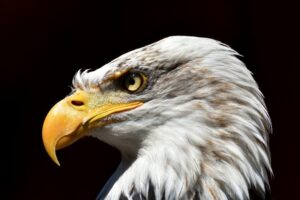On Wednesday of next week, America will celebrate its 242nd birthday. Most will have a day off to picnic, swim, and enjoy fireworks. As we mark this milestone in our nation’s history, it’s a great time to pause and consider God’s creative genius demonstrated in our national bird, the Bald Eagle. 
Although Ben Franklin proposed the Wild Turkey for our national symbol, Congress approved one in 1782 designed by their secretary, Charles Thomson, that featured the Bald Eagle instead. Ever since, this regal bird has come to symbolize strength and resolve and is prominently featured today on our currency, the top of our flagpoles, and many other public places.
Though threatened by extinction just a few decades ago, Bald Eagles have bounced back from the brink and now even inhabit areas they never did previously. Even in our own valley, we are privileged to occasionally glimpse one perched way up in a tree or soaring high overhead. These magnificent birds are truly an engineering marvel.
Weighing an average of fourteen pounds, an adult can actually carry a fifteen pound payload of salmon or other cargo, lifting it into the sky for consumption at a secure location. Although Agur was unable to understand the eagle’s ability to fly in Proverbs 30:19, we now know this is possible because of its enormous seven to eight foot wingspan and powerful flight muscles.
Most all birds were designed to fly with hollow bones and aerodynamic wings, but the eagle was given special gifts. The combined weight of all of her more than 7,000 feathers is less than a pound and half and her skeleton only weighs half that. These efficiencies enable this stately creature to fly some 45 miles per hour and dive up to 100.
God has also blessed this bird with incredible visual abilities. With eyesight that is 4-5 times stronger than our own, it can pinpoint prey at great heights. If we could see as well as they, we would be able to detect an ant on the ground from the top of a ten story building. Eagles can also see into the ultraviolet end of the light spectrum that is invisible to humans and they can even correct for the refraction of light in water that could otherwise cause problems for them when they go fishing for dinner.
In addition to their vision, Bald Eagles have other particular advantages that make them the penultimate predator. After locating a target from high above and rapidly diving towards it, upon impact, the eagle’s toes grasp the victim with up to 400 pounds of pressure per square inch. That’s about ten times the average human handgrip. Factor in the razor sharp talons on the end of each toe and you have a lethal combination that has spelled doom for many unsuspecting fish and rodents.
Eagles also have strong family structures and typically mate for life. Their nests, or eyries, are the largest of any bird with a diameter of up to ten feet, a depth of nearly twenty, and a weight of up to 3 tons. The female lays an average of 2-3 tennis ball sized eggs per clutch and she will incubate them for five weeks until they hatch. Once they do, both parents assist in feeding the young which are able to fly in 10-12 weeks. After several months of trial and error, they eventually learn to hunt themselves and leave home to establish their own families, nests, and territories.
In Exodus 19:4, God tells the Hebrews that He carried them on eagles’ wings and brought them to Himself. And Isaiah 40:31 proclaims a great promise that, “those who hope in the Lord will renew their strength. They will soar on wings like eagles; they will run and not grow weary, they will walk and not be faint.” These images powerfully remind us of God’s love and care and utilize this incredible bird to help drive His point home.
Indeed, the same God who created the bird that now represents our country made us. As we celebrate America’s birthday this coming week, let us thank Him for the Bald Eagle and ask Him for the same spiritual and moral strength, resolve and vision that He gave them physically to face the challenges that come our way.
In Jesus, George